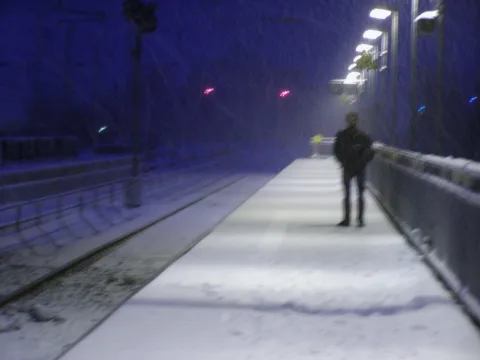Winter weather can get pretty crazy…

The combination of snowy weather, cold temperatures, strong winds, and other wintry conditions can sometimes cause some awesome — and bizarre — phenomena.
If you haven’t witnessed any odd winter conditions yourself (or your simply love seeing weird weather events — as I do), then you’ll appreciate these incredible photos and videos of strange winter weather.
#1 – Sun Dogs
Sun dogs are a cool optical phenomenon that commonly occur in the winter, when ice crystals for high in the atmosphere.
When sunlight passes through these plate-flat, hexagonal ice crystals in cirrus clouds, they refract the light — as does a prism.
This prismatic effect creates rainbow-colored blobs in the sky at an angle of 22 degrees from the location of sun.
While sun dogs can be seen virtually anywhere in the world and potentially any time of year, they are most common during the winter when the sun is low and ice crystals are most likely to form in the atmosphere.
Here are my best tips for viewing sun dogs.
#2 – Thundersnow
Have you ever heard thunder during a snow storm? If you have, then you’ve experienced thundersnow.
Thundersnow is a relatively unusual occurrence that happens when snow storm clouds (which are ordinarily flat and don’t grow very tall into the atmosphere) begin to grow vertically.
When snow storm clouds turbulently grow upward — like cumulonimbus clouds do with warm updrafts in the moist summertime air — electrical charges can really get cooking in the snow cloud.
These swelling updrafts can create turrets, or towers, at the top of the cloud that help spark thundersnow.
Here’s when, why, and where thundersnow happens the most.
#3 – Snowmageddon
If you remember the winter of 2010, you’ll probably recall that tons of snow fell in many cities across the United States during a massive blizzard February 5th through 6th.
The extreme blizzard brought major urban centers to their knees, overwhelmed plows and salt crews, and effectively shut down business for millions of folks who had to dig out from one of the messiest snow storms in years.
Massive blizzards are essentially wintertime hurricanes. They can:
- Cause freaky amounts of snow
- Create snow drifts that pile up 10 feet high or taller
- Bring cold, windy weather across massive regions
What do you think about the media naming large winter storms?
#4 – Rime
Ever see photos of snowy, windswept formations of styrofoam-like snow on trees, cars, or telephone poles?
It’s called rime. It forms when supercooled water meets the surface of snow, causing the growth of icy formations that grow into the wind.
Rime most commonly forms in the mountains, where quickly rising air prevents water droplets from forming into snow or graupel. The water droplets are well below freezing. Upon touching a solid surface, they freeze into pointy forms.
Rime differs from the similar-looking hoar frost in a few ways, but perhaps the most striking difference is that hoar frost tends to form uniformly around objects, while rime generally grows predominately in the direction of the wind.
Here’s a little more about the mystery of hoar frost.
#5 – Snow Tornadoes & Snownadoes
While very rare and, by some accounts, a meteorologically controversial and unverified situation, tornadoes sometimes form in the wake of passing winter cold fronts and during other turbulent wintry weather.
Tornadoes may also form along advancing warm fronts — sometimes picking up snow on the ground that has not yet melted.
When snow on the ground is swept into the tornadic vortex, it can cause a whitish tornado that many refer to as a snow tornado or snownado.
Even weirder… check out this winter waterspout that occurred during a snow squall.
#6 – Black Ice
Black ice is a thin icy layer that forms on relatively dry roadways.
You can usually see the dark roadway under the thin layer of ice, giving rise to the name “black ice.”
This transparent sheet of ice can look virtually invisible to motorists, thus taking many unsuspecting drivers (dangerously) by surprise as their cars glide across the glazed road surface.
Black ice is responsible for many winter car crashes. It’s often the reason that interstate pileups involving 10, 20, even 70+ cars happen during the winter.
https://www.youtube.com/watch?v=JDsclaXxy6c
#7 – Virga
Virga is rain or light snow that evaporates before reaching the ground.
I’ve seen lots of snowy virga in the North — which looks like blocks, streaks, or shafts of white or light-gray precipitation hanging from the bottom of a cloud.
Virga is most often seen in areas where the lower atmosphere above the ground is too dry to support precipitation falling from moister levels of the atmosphere.
How does it rain when the humidity is so low?
#8 – Graupel
Graupel is a type of precipitation that occurs when supercooled water droplets form on falling snowflakes.
While graupel is often confused with hail, the 2 are actually very different:
- Hailstones are hard pellets of ice that may be smaller than the size of a pea or larger than baseballs.
- Graupel (also known as “soft hail”) consists of small balls of rime that generally measure 2 to 5 millimeters wide.
Here are all the types of hail.
https://www.youtube.com/watch?v=XzrlM9iKMWM
More Weird Winter Weather Phenomena
- 5 Weird Winter Weather Events Happening Now That Shouldn’t Be
- The Factors That Affect Weird Winter Weather
- Why The Weird Winter Weather Will Continue
- Tools To Forecast Winter Weather
- Is El Nino To Blame For Weird Winter Weather?
- 59 Cold Facts About Winter
- How Weird Winter Weather Affects Birds
- Global Warming & Weird Winter Weather




